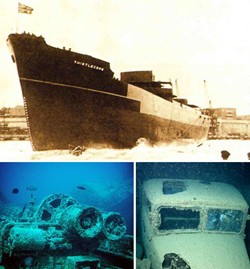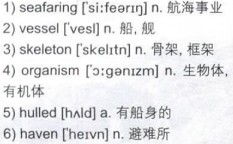 Throughout 1)seafaring history, ships and sailors have been lost to storms, accidents and war. Until recently, most of these ships were fragile wooden sailing 2)vessels, their 3)skeletons quickly eaten away by marine 4)organisms. Now, large steel-5)hulled vessels roam the seas. Thousands of these mighty ships have been lost in times of war and in times of peace.
Throughout 1)seafaring history, ships and sailors have been lost to storms, accidents and war. Until recently, most of these ships were fragile wooden sailing 2)vessels, their 3)skeletons quickly eaten away by marine 4)organisms. Now, large steel-5)hulled vessels roam the seas. Thousands of these mighty ships have been lost in times of war and in times of peace.
The bones of great metal ships, unlike the wooden vessels of old, survive the ravages of the sea long enough to become home and 6)haven for marine life of all kinds. 7)Shipwrecks are ready-made 8)artificial reefs. They often provide the only hard surface and structure in the midst of a sandy bottom, something many sea creatures need.
This ship has been underwater for only five days. Its surface is still clean. Six weeks later, the wreck is covered with a 9)slimy layer of 10)algae, but it is still recognizable as a ship. Soon, animals that need to attach themselves to a hard surface, like this 11)tunicate and these 12)featherduster worms, make the wreck their home.
In warm waters, 13)coral polyps settle on the wreck and begin the process of building a rock-like 14)crust on the ship. Small fish are attracted and graze on all of these creatures. Larger fish come to feed on the small fish that hide in the 15)wreckage. Eventually, the largest 16)predators are attracted to the 17)abundant life on the shipwreck.
Shipwrecks give us valuable information about how marine plants and animals develop. We know exactly how long this wreck has been under water and how long marine life has been growing on it. Yet even the strongest steel shipwreck will eventually be destroyed by the 18)currents and 19)corrosion. But long after this wreck has been broken apart, it will still act as a reef. Layer upon layer of marine life has formed a structure that is now more natural than artificial, and will remain an island of life under the sea.
纵观整个航海史,船只和水手常因暴风雨、意外和战争遇难。直到不久前,大多数船只还是脆弱的木质帆船,它们的骨架很快就被海洋生物侵蚀殆尽。如今,各种具备钢制船身的大船在海洋中徜徉。无论是在战争年代还是和平年代,成千上万这种强大的船只消失在海洋当中。
与老式的木制船不同,大型金属船只的骨架历经海洋的磨砺,经过漫长的年代,最终变成各种海洋生物的家园和避风港。船只残骸是现成的人工礁石。在沙石遍布的海底,它们提供了仅有的坚硬表面和结构,这也是许多海洋生物极其需要的。
这艘船在水下仅有五天。它的表面还是干干净净的。六周后,其残骸就被一层黏糊糊的海藻覆盖了,但你仍然能够看出它是一艘船。过了不多久,需要依附在坚硬表面的动物,如被囊动物和这些毛掸虫,就将这些残骸变成了自己的家园。
在温暖的水域,珊瑚虫居住在残骸上,开始在船身表面修筑如岩石般坚硬的外壳。小鱼被吸引至此,以这些生物为食。大鱼前来吃躲藏在残骸中的小鱼。最后,最大型的捕食者被残骸间丰富的生物吸引过来。
船只残骸为我们提供了极有价值的信息,让我们了解海洋动植物的生长情况。我们能够确切地知道这些残骸在水中有多长时间,以及海洋生物在其上面生长了多久。然而,即使是最坚固的钢制残骸最终也会被水流和侵蚀摧毁。但即使在残骸分崩离析之后,它仍然充当着礁石的角色。一层又一层的海洋生物已经建立起一种组织结构,如今的残骸更像是大自然的杰作,而非人工制品,它们从此成为大洋之下的一个生命之岛。


